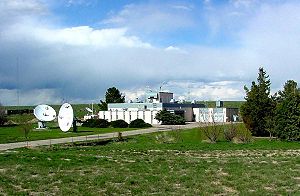The most common way for radio waves to travel is in a straight line of sight from one antenna to another.
This is most common for radio waves using frequencies of 30 MegaHertz (30 MHz or 30 million changes of direction per second)
or higher.
Radio sky waves between 3 and 30 MHz can also reflect off the electrically charged upper atmosphere,
which is called the Ionosphere, to then bounce thousands of miles around the earth.
Radio Waves below 3 Mhz can hug the earth's surface to travel hundreds of miles using ground waves.
Click here to see line of sight
Click here to see Skywaves and groundwaves
WWV and WWVH

Radio station WWV is located in Fort Collins Colorado and WWVH is located in Hawaii. Both provide precise
time signals and transmit exactly on the frequencies of 5, 10, 15 and 25 MHz. They also provide infomation
on how well the Ionosphere is bouncing radio signals today.
They can be used to set your clock, to calibrate your receiver and transmitter, and
to see how well radio signals can travel to and from Colorado and Hawaii.
Local vs DX - Signals from nearby stations are called local, while those from far away
places are called "DX". "DX" is the old Morse Code abbreviation for "distance".
The FCC is the Federal Communications Commission. It regulates and issues radio
licenses in the United States. The ITU is the International Telecommunications Union
and the agency of the United Nations that establishes international standards for radio.
Requirement 3
|

